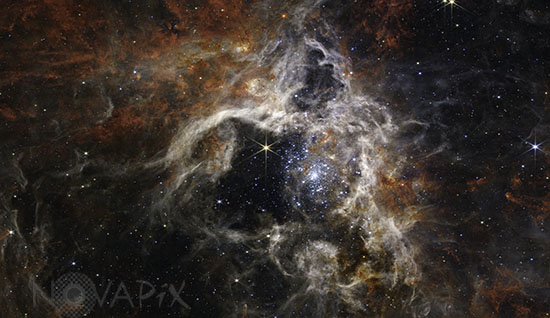Photo Agency - Astronomy - Space - Nature

The Tarantula Nebula in Dorado
author: NASA/ESA/CSA/STSCI/Novapix
reference: a-neb20-70024
Image Size 300 DPI: 123 * 71 cm
The James Webb Space Telescope reveals details of the structure and composition of the nebula, as well as dozens of background galaxies.
Stellar nursery 30 Doradus gets its nickname of the Tarantula Nebula from its long, dusty filaments. Located in the Large Magellanic Cloud galaxy, it’s the largest and brightest star-forming region near our own galaxy, plus home to the hottest, most massive stars known.
The center of this image, taken by Webb’s Near-Infrared Camera instrument (NIRCam), has been hollowed out by the radiation from young, massive stars (seen in sparkling pale blue). Only the densest surrounding areas of the nebula resist erosion, forming the pillars that appear to point back towards the cluster of stars in the center. The pillars are home to still-forming stars, which will eventually leave their dusty cocoons and help shape the nebula.
Unlike in our Milky Way, the Tarantula Nebula is producing new stars at a furious rate.
Contact : Stéphane Aubin +33-(0)9-51-26-53-76
© Novapix - All rights reserved


